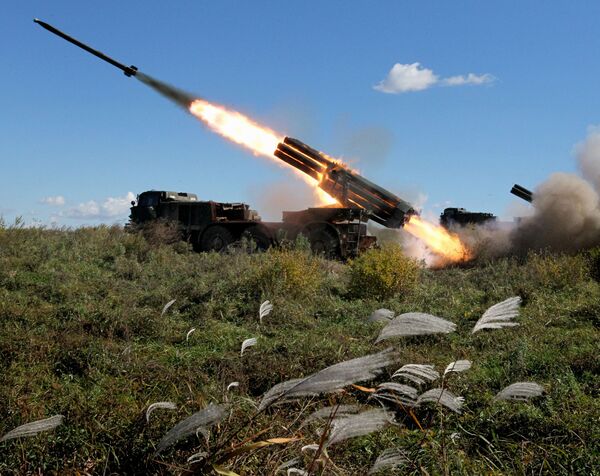MOSCOW (Sputnik) – The commemorative day was established by the May 31 2006, executive order of the Russian president, "Establishing Professional Holidays and Commemorative Days in the Armed Forces of the Russian Federation." On this day, the people of Russia honor military specialists for their contribution to national defense and security. It is also intended to help revive and build on Russian military traditions and to make military service more prestigious.
Russian artillery, one of the oldest service branches, was first mentioned by medieval chronicles in 1382 when the people of Moscow used the first artillery systems to defend their city from the forces of Khan Tokhtamysh. Called Tyufyaks, these cannons fired "drob," or pieces of iron and small stones, similar to grapeshot. Muscovites also used larger cannons called Pushki Velikiye, or Great Guns.
READ MORE: Super Boomer: What's So Special About Russia's New Borei-A Missile Sub?
Artillery became an independent service branch in the 16th century and proved capable of supporting infantry and cavalry operations on the battlefield. Until the late 17th century, Russian artillery systems were operated by gunners and riflemen called Pishchalniki (Harquebusiers or Musketeers). In the early 18th century, Russian artillery units were subdivided into field artillery, including regimental artillery, siege and fortress artillery. Horse-drawn artillery units fully asserted themselves in the late 18th century, and the country started establishing artillery regiments and brigades in the early 19th century. Mountain artillery units were established in the 1840s.
During the Russo-Japanese War of 1904-1905, Russian gunners fired their artillery systems from concealed positions for the first time in history, and the first mortars were also used during that conflict. By World War I, waged between 1914-1918, all artillery units were subdivided into field (light, horse-drawn and mountain), heavy field and heavy siege artillery. Anti-aircraft and self-propelled guns were developed during World War I, followed by anti-tank artillery somewhat later.
Multiple launch rocket systems were developed during World War II of 1939-194. Anti-aircraft, self-propelled and anti-tank artillery systems were also used on a large scale.
Today in Russian Military History
— Ryan Stavka (@SgtStavka) 19 ноября 2017 г.
November 19th
Day of Missile Forces and Artillery!
Celebrate accordingly!#artillery #russianarmy #russianhistory pic.twitter.com/9bZomMNKzh
Artillery systems have heavily influenced the outcome of all wars and battles involving the Russian army. Figuratively called the "God of War" in 1940, they lived up to their name on the battlefields of the Great Patriotic War of 1941-1945.
READ MORE: Locked and Loaded: Russia's Tu-22M3 Bombers to Boast Advanced Cruise Missiles
During virtually all operations, artillery units accomplished all the main tasks and inflicted most of the casualties on the enemy.
Over 1,800 gunners became heroes of the Soviet Union for their wartime exploits, and 1.6 million officers and soldiers were decorated for bravery during the Great Patriotic War.
On November 19, 1942, the Red Army launched its counter-offensive near Stalingrad. During its initial phase, artillery units inflicted heavy casualties on the enemy and disrupted the entire system of enemy defenses. This prevented substantial Soviet casualties, allowing Soviet forces to advance successfully, encircle enemy units in and around Stalingrad, and defeat them completely.
On October 21, 1944, the Presidium of the USSR Supreme Soviet (Parliament) issued its decree instituting Artillery Day, to be observed every November 19 to commemorate the heroic feats of gunners during the Soviet counteroffensive near Stalingrad that began November 19, 1942.
Artillery systems continued to develop after the war, with experts inventing new, more advanced and more powerful weaponry.
In 1961, the Soviet Union established the Missile Forces and Artillery as an independent service branch incorporating all available artillery and missile elements of that period.
In 1964, Artillery Day was renamed as Missile Forces and Artillery Day. In 1988, the country started observing this day every third Sunday of November and every November 19 from 2006 onward.
Today, missile forces and artillery units of the Russian Armed Forces include missile and artillery units of the Ground Forces, artillery units of the Navy’s coastal defense elements and artillery units of the Airborne Force consisting of missiles, multiple launch rocket systems and artillery brigades, artillery and multiple launch rocket system regiments, large-caliber artillery battalions, detached artillery reconnaissance battalions, as well as artillery units of motorized rifle, tank, Airborne Force and Marine elements.

Under its action plan, the Russian Defense Ministry is implementing a number of measures to overhaul the structure, organization, and fighting and numerical strength of missile forces and artillery units.




